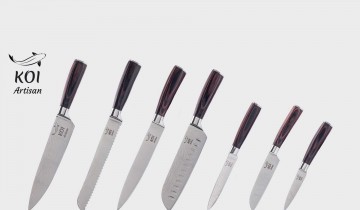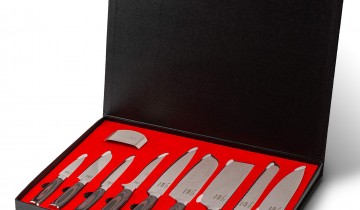Because there are so many task-specific possibilities, kitchen knives are one of the most unusual cooking instruments available.
How about slicing some bread? Your bread knives are on your side. Is it necessary to peel fruits and vegetables? You’re covered with paring knives. There are a plethora of ways to stock your knife block.
Professional chefs frequently have access to an entire arsenal of knives (some uni-tasker, some multipurpose), whereas the home cook is likely to simply have a couple to pick from when performing kitchen activities.
The Koi Artisan chef knife comes in handy here. This multi-purpose kitchen knife is the workhorse of household kitchens all around the world. You’ll learn what a chef’s knife is, what it’s used for, if it can be used for carving, when to use one, and how to sharpen one in this article.
What is a chef’s knife:
Chef’s knives are multi-purpose kitchen knives made of stainless steel and carbon steel that are typically 8 inches long.
Two of its distinguishing qualities are a prominent tip and a sharp edge with a sloping curve. The curve of a chef’s knife allows for the usage of the knife’s signature rocking motion cutting method.
Because the knife is designed to be rocked back and forth from tip to heel, with the item you want to cut in the middle, the rocking motion cutting technique gets its name. At every times during this procedure, a different section of the knife is in touch with the cutting board. This is considerably different from the approach employed with a Santoku knife, which has a straight blade.
If you’re looking for a chef’s knife, seek for one that is full tang and fully forged. This indicates the knife is fashioned entirely of one solid metal rod, from tip to hilt. Full-tang and completely forged knives are significantly more durable and long-lasting than knives made more cheaply. As a result, all Made In knives are fully forged and full tang.
What a chef’s knife is used for:
KOI Artisan Chef’s knives are as versatile as they come. They are equally adept at tiny jobs such as cutting herbs, julienning carrots, and mincing garlic, as well as major ones such as dicing a huge onion, spatchcocking a chicken, and slicing a ham.

Modern American household kitchens are frequently equipped with only a few knives, and a multipurpose knife like a chef’s knife is a popular choice. This, along with a paring knife (for delicate peeling and slicing) and a utility knife (for jobs like slicing bread), creates a tiny yet powerful blade line-up.
When to use a chef’s knife
Chef’s knives and Santoku knives are great multi-purpose knives because they can be used all the time! If you’re not sure which knife to use, a chef’s knife is a great option because it’s likely to be up to the job!

Slicing crusty items like bread, peeling foods like potatoes and apples, and cleaving bones are some examples of when you might want to use a different knife.
How to sharpen a chef’s knife
Chef’s knives should be honed and sharpened with an honing rod and a whetstone. Sharpening can also be done with electric sharpeners, albeit they don’t provide the same level of precision as a human method. How to Sharpen Kitchen Knives is an excellent resource from Cook’s Illustrated.
Using the services of a professional knife sharpener is always a fantastic method to keep your blades sharp as new if you have the option. It’s likely that there’s a knife sharpener near you that you’re unaware of.

You’re well on your way to improving your cutlery game now that you know what a chef’s knife is, what it’s for, when to use one, if it can be used for carving, and how to sharpen one. On our knife collection page, you may look through our selection of completely forged and full tang knives.
In Search of the Best Chef’s Knife
A knife is likely the only kitchen utensil that must be used every time food is prepared. Even a stove is optional—you can create a salad or tartare without one, for example—but a sharp chef’s knife is essential. Humans’ need on knives dates back a long way—some experts believe that the time when our pre-human ancestors used a primitive stone blade to hack up a cadaver roughly two and a half million years ago was what truly made us human. We were able to consume more calories and relate to each other differently because we could cut up meat, share it, store it, and carry it. Our brains became larger, our jaws shrank, our tools became more sophisticated, and our teamwork improved– The knife has inspired the entire course of human history. All of this has led you to Williams Sonoma, where you’re choosing between a KOI Artisan and a Global.
The big picture is that if you’re looking for an all-purpose 8-inch chef’s knife in a reasonable price range, you have a choice between heavy-duty, German-style models, which are usually made with slightly softer steel alloys (“alloy” simply means a mixture of different metals), and lighter Japanese-style models (like Shun), which are usually made with harder steel alloys. Neither is inherently superior to the other. They simply aren’t the same, particularly in terms of how they feel and move in your palm.



 No products in the cart.
No products in the cart.